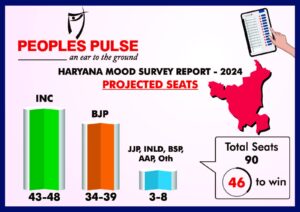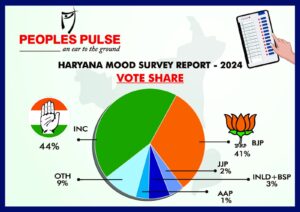Anti-incumbency factor, Agnipath scheme, farmers' protest, unemployment, etc., are likely to help Congress win 43-48 seats in Haryana Assembly polls.
Published Jul 26, 2024 | 12:12 PM ⚊ Updated Jul 26, 2024 | 12:13 PM

The mood survey predicted that Congress would poll around 44 percent of votes, the BJP 41 percent, INLD and BSP three, AAP one, and others nine. (Sanyam Bahga/Wikimedia Commons)
The Congress seemed to have a slight edge over the ruling BJP-led alliance in the upcoming election to the Haryana Legislative Assembly, according to a survey.
Hyderabad-based Peoples Pulse’s mood survey predicted the Congress to win between 43 and 48 seats — just around the simple majority of 46 to form a government — in the 90-member Assembly.
The BJP might win 34 to 39 seats while the Jannayak Janta Party (JJP), Indian National Lok Dal (INLD) and Bahujan Samaj Party (BSP) combine, Aam Aadmi Party (AAP), and Independents were projected to bag three to eight seats.
The survey — the first ground-level study ahead of the elections — found that at least 15 key seats would decide the winner. The bipolar contest would be a close one in all constituencies, barring a few.

Congress seems to have an edge over BJP.
Coming to vote share, the survey predicted that Congress would poll around 44 percent, the BJP 41 percent, INLD and BSP three, AAP one, and others nine. It put the JJP’s likely share at a mere two percent.
The survey also predicted the “complete marginalisation” of regional parties like JJP and INLD.
“The JJP, which had secured 14.84 percent votes in 2019, saw its vote share in the recent Lok Sabha polls plummet to 0.87 percent, and is unlikely to improve on it in the Assembly polls,” it said.
Currently, the ruling BJP and JJP have 40 and 10 seats, respectively, in the Nayab Singh Saini-led government. The Congress has 31 MLAs, while Independents numbered seven with the INLD and Haryana Lokhit Party (HLP) having one seat each.
Elections to Haryana’s 15th Legislative Assembly are likely to be held in October.
The survey found the Congress consolidating its traditional voters, and a majority of farmers (65%) backing the party. Jats and Dalits, too, were favouring the Congress.

Congress wrested 5 seats from BJP in the Lok Sabha polls.
Appointing an OBC chief minister did not yield the expected results for the BJP in the Lok Sabha elections. The mood survey also found dwindling Dalit and OBC support for the BJP, besides an anti-incumbency feeling across the state.
The Congress had wrested five seats from the BJP in the 25 May Lok Sabha polls. In 2019, the BJP had won all 10 seats in Haryana, but it could manage only five in the recent polls.
The Congress gained a 15 percent vote share in the Lok Sabha polls compared to 2019, while the BJP’s fell by almost 12 percent. The Congress also led in 42 Assembly seats during the general elections.
AAP (now contesting separately) secured a lead in four, while the BJP was ahead in 44 seats.
The youth across the state were bothered about increasing unemployment, and they questioned both the state and central government about it. They felt the Agniveer scheme affected the attraction of serving in the armed forces.

Bhupinder Singh Hooda is more popular that Nayak Singh Saini.
Respondents — both men and women — across regions and communities expressed anger over inflation. In rural areas, barring the Aheerwal region, the majority of farmers highlighted the Haryana government’s role in crushing the farmers’ protest.
Only 40 percent of the participants favoured one more chance for the BJP, while 48 percent wanted the saffron party out. Twelve percent lacked an opinion.
Interestingly, former chief minister Bhoopinder Singh Hooda has a 10 percent lead over Saini as people’s choice for the post of chief minister.
Local issues dominated the discourse, apart from farm distress, Agniveer, unemployment, and basic livelihood. The BJP which pushed a successful narrative in 2014 and 2019, seemed falling behind in responding to people’s issues.
Besides local issues, MLAs’ performance, infrastructure problems, etc., would decide the votes. National issues and the Modi factor are likely to take a backseat.
The family ID (Parivar Pehchan Patra) initiative, too, might be reflected in the polls. Incorrect surveys have deprived many families of government facilities, impacting their economic situation and living standards.
A strong anti-incumbency feeling against all sitting MLAs, including ministers, was evident across the state. Fielding them again would affect the parties’ prospects.
The survey found that the voters had lost their faith in the JJP and Jats were unlikely to vote for the party. The INLD-BSP alliance might not make any major change in the political scenario. AAP might end up without even a single seat.
“According to all parameters, the Congress holds a slight edge. As of now, it is going to be a close election,” the survey said.
“Haryana is headed for an exciting election season with several possibilities till the government takes office,” it added.
The survey also found the BJP holding ground in Faridabad (barring Nuh) and Aheerwal regions, while the Congress seemed to be picking up in Hisar, Ambala, and Rohtak regions.
The mood survey was conducted over a month between 25 June and 24 July. Six teams covered the state’s six regions, Hisar, Karnal, Gurugram, Faridabad, Rohtak, and Ambala.
Researchers were deployed in all 90 segments. The survey followed a systematic stratified random sampling model. Mixed methods were used to collect and assess 15,000 samples, covering gender, demographic, and age divide.
Face-to-face freewheeling conversations were held based on a structured questionnaire, and 125-150 samples from each constituency were collected. The samples reflected the ground situation in terms of caste, religion, community, and age. Gender was given equal representation.
The respondents were chosen through purposive sampling and employing a qualitative inferential method. The researchers also interacted with a couple of political observers to cross-check facts and figures.
(Edited by Majnu Babu)
(South First is now on WhatsApp and Telegram)
